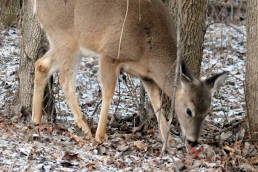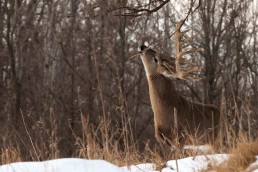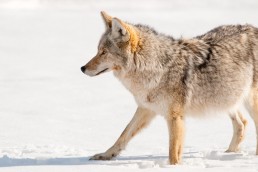Bowhunting Late-season Whitetails
SHARE THIS POST
A biting wind tears at the face like sandpaper. Cold chills your body to the core. Late-season bowhunting is not for those less than fully committed. Weather and a reduced deer herd make for hard work. Often the hunt is in cold and snow. To the hunter willing to forgo comfort, this time can provide an opportunity to find a big buck.
Hunting pressure from other humans is less at this time due to most hunters having already done their thing and gone home weeks ago. Less-dedicated hunters have given up and gone home in frustration over the fact that it is difficult to hunt deer.
The experience of being in the woods during snowfall provides a chance to see Mother Nature at her harshest and yet most beautiful. The snowscape of winter can be a joy to behold. Fresh fallen snow muffles the sounds of the outdoors, and also provides an easier chance to observe the tracks of the critters in the woods.
Skilled hunters can tell much from tracks. They can find dominant bucks that are often wall hangers. Late season is the trophy hunter’s chance to shine.
Old herd bucks have tracks that show up vividly in snow. The old guy will walk with their front hooves angled 30 percent from center on the hind feet. In addition, he does not place his hind feet in the track of his front ones.
When watching an old buck from a distance, it is easy to spot him by the way he walks. He looks like he is doing the shuffle. Does and young bucks are more graceful. The old buck cannot carry his neck and head the way a lesser buck or doe will do. The swelling of the adrenal glands in his neck, during and just after the rut, cause him to carry his head low, like he is sneaking through brush. Many believe that he is hiding his horns or smelling the ground in search of a doe that has recently passed the location.
It is more likely that this is more comfortable.
Old bucks are solitary after the rut and move along their own trail, and not on the herd trail. The herd trail is usually wide and well beaten down from extensive use. The old guy’s trail will seldom be 5 inches in width and not well traveled. He uses it one way going to the feeding area, and then uses a different trail in moving from the feeding to his bedding area. A buck’s trail also doubles as an escape route.
Knowing this, hunters can wait in ambush on each trail, depending upon the time of the day. Deer move to feeding areas in the late afternoon and toward bedding areas in the morning.
Are you enjoying this post?
You can be among the first to get the latest info on where to go, what to use and how to use it!
Hunters, who work with weather fronts passing through, improve their chances. The weather just ahead of a front in the late season usually is cloudy and often snowy. Deer feed heavily just before a front and right after it passes. They lay up for long periods of time, waiting for a front to pass.
On cloudy days, deer feed in the open and lay up in the edges of cover. On the days of really bad weather, they head for the heaviest cover of forest, swamps and sloughs.
Light snow or drizzle cause deer to move around a lot, feeding and bedding down frequently during the day. This is most likely because as their fur gets wets, it loses some of its insulating capacity. Deer move to get water off the coat and to feed, so that they can take in more calories to help maintain body temperature.
Whitetails in areas of heavy human population take advantage of small islands of habitat often overlooked by hunters. Late-season hunters are wise to seek out small areas of brush or marsh in the middle of otherwise open country. The area may be only big enough to hide a single buck, but chances are he will be a big one.
Other spots for late season bucks are brushy tangles connecting one thick wooded area with either another brushy area, thick slashings in a clear-cut, heavy wooded area, pond or swamp with heavy cover on the border.
Swampy areas near public hunting areas are often overlooked by hunters who do not want to take the trouble to explore them. Hunters can set up on some of the open game trails and lay in wait.
Late-season hunters who are imaginative and pay attention to detail will do well. Do not overlook a single patch of habitat. Study the habits of your quarry and learn to recognize observable habitats.
With luck and having done the homework, late-season hunters probably stand a better chance of meeting up with that old dominant buck. Whether the hunter takes him or not depends upon his ability. But that is the subject for another article.
MWO
SHARE THIS POST
Did you enjoy this post?
You can be among the first to get the latest info on where to go, what to use and how to use it!
Don Gasaway
Don Gasaway is a veteran freelance outdoor writer from Marion, Ill. He may also be found at: https://www.facebook.com/DonGasawayWriter and facebook.com/Wandering Angler. Comments are welcome



